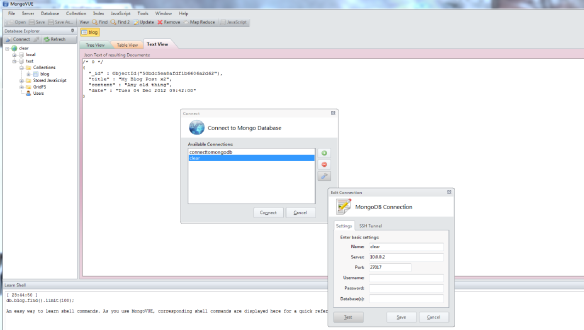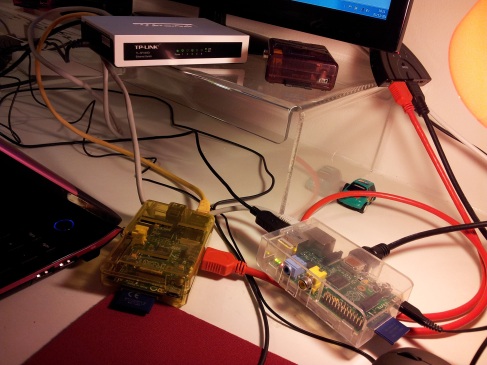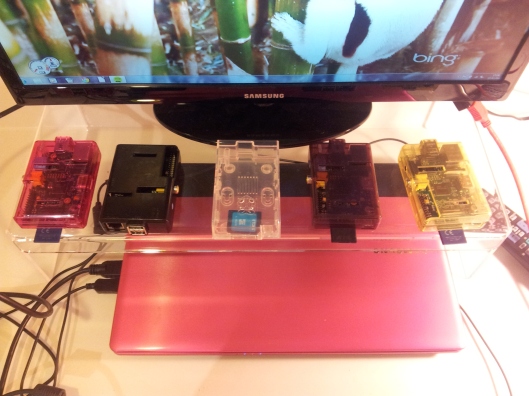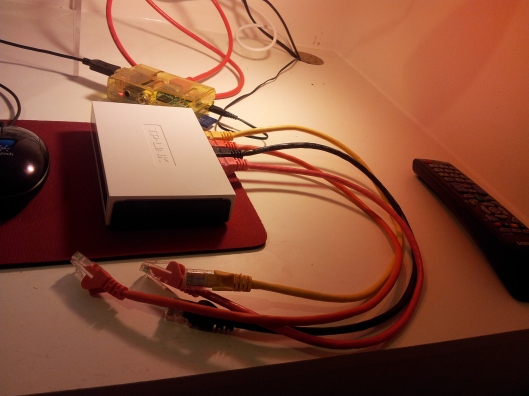 I’m having another attempt and building out my cluster today. Following Simon the PiMan’s guides
I’m having another attempt and building out my cluster today. Following Simon the PiMan’s guides
- http://www.simonthepiman.com/beginners_guide_find_my_network_settings.php
- simonthepiman.com/how_to_setup_your_pi_for_the_internet.php
- http://www.simonthepiman.com/how_to_setup_remote_access.php#raspberrypi
I just want to get one or 2 R Pis connected to the network switch and the Dell (acting as master).
I fire up the Dell and call MongoD (which I haven’t used for a couple of weeks), to get a surprising error:
old lock file: /data/db/mongod.lock. probably means unclean shutdown recommend removing file and running --repair see: http://dochub.mongodb.org/core/repair for more information
The right way to shut down Mongo
I guess I must have done something wrong the last time I had it open. To ensure a clean shut down, use the mongod –shutdown option, your control script, “Control-C” (when running mongod in interactive mode,) or kill $(pidof mongod) or kill -2 $(pidof mongod).
Finding out/remembering where you installed MongoDB
$ sudo find / -type d -name mongo
This will search from root (/) for directories named ‘mongo’
Reveals I installed everything to /usr/bin
Find out where you installed the directories for $DBPATH, check the filesize for mongod.lock
$ locate /data/db
/data/db- Note to self, create this in the same tree as the Mongo directories next time!
cd /data/db
ls -l
-rwxr-xr-x 1 stuart stuart 0 Jan 6 22:00 mongod.lock
If the mongod.lock file in the data directory specified by dbpath, /data/db by default, is not a zero-byte file, then mongod will refuse to start.
However, as above, you can see that the filesize is 0 bytes for mongod.lock, so, I’m not quite sure what the problem is.
Repairing MongoDB
$ sudo mkdir /data/db/db0
– Mongo attempts to create a new directoryand move the old/repaired lock file. As I seem to have some ongoing permissions problems, i pre-create this folder.
$ sudo mongod –dbpath /data/db –repair –repairpath /data/db0
Feedback from the shell below suugests it has worked…
stuart@debian:/data/db$ sudo mongod –dbpath /data/db –repair –repairpath /data/db0
Sun Jan 6 22:33:30 Mongo DB : starting : pid = 16652 port = 27017 dbpath = /data/db master = 0 slave = 0 32-bit
** NOTE: when using MongoDB 32 bit, you are limited to about 2 gigabytes of data
** see http://blog.mongodb.org/post/137788967/32-bit-limitations for more
Sun Jan 6 22:33:30 finished checking dbs
Sun Jan 6 22:33:30 dbexit:
Sun Jan 6 22:33:30 shutdown: going to close listening sockets…
Sun Jan 6 22:33:30 shutdown: going to flush oplog…
Sun Jan 6 22:33:30 shutdown: going to close sockets…
Sun Jan 6 22:33:30 shutdown: waiting for fs preallocator…
Sun Jan 6 22:33:30 shutdown: closing all files…
Sun Jan 6 22:33:30 closeAllFiles() finished
Sun Jan 6 22:33:30 shutdown: removing fs lock…
Sun Jan 6 22:33:30 dbexit: really exiting now
Or, to wipe your data files without preserving the original files, do not use the –repairpath option, as in the following procedure:
- Remove the stale lock file:
rm /data/db/mongod.lock
Replace /data/db with your dbpath where your MongoDB instance’s data files reside.
Warning: After you remove the mongod.lock file you must run the –repair process before using your database.
- Start mongod using –repair to read the existing data files.
mongod --dbpath /data/db --repair
When this completes, the repaired data files will replace the original data files in the /data/db directory.
- Start mongod using the following invocation to point the dbpath at /data/db:
mongod --dbpath /data/db
Port already in use?!
After repairing Mongo by clearing out the old lock, I try to start it afresh.
stuart@debian:/data/db$ mongod
mongod –help for help and startup options
Mon Jan 7 12:01:20 Mongo DB : starting : pid = 17622 port = 27017 dbpath = /data/db/ master = 0 slave = 0 32-bit
** NOTE: when using MongoDB 32 bit, you are limited to about 2 gigabytes of data
** see http://blog.mongodb.org/post/137788967/32-bit-limitations for more
Mon Jan 7 12:01:20 db version v1.4.4, pdfile version 4.5
Mon Jan 7 12:01:20 git version: nogitversion
Mon Jan 7 12:01:20 sys info: Linux murphy 2.6.32.14-dsa-ia32 #1 SMP Thu May 27 16:19:20 CEST 2010 i686 BOOST_LIB_VERSION=1_42
Mon Jan 7 12:01:20 waiting for connections on port 27017
Mon Jan 7 12:01:20 listen(): bind() failed errno:98 Address already in use for port: 27017
Mon Jan 7 12:01:20 MiniWebServer: bind() failed port:28017 errno:98 Address already in use
Mon Jan 7 12:01:20 addr already in use
Mon Jan 7 12:01:20 warning: web admin interface failed to initialize on port 28017
It seems this is a recognised problem. It seems that if you installed MongoDB the ‘sudo apt-get…’ way then Ubuntu seems to boot a mongo DB on startup (like a Windows service).
Here’s a quick fix here’s to find and kill the Mongo server process and start completely afresh.
Get the process list:
$ ps -eF | grep 'mongo\|PID'
This will return the PID(s) [1776] which can then be used to kill the process and hopefully close the sockets as well.
$ ps -ef | grep ‘mongo\|PID’
UID PID PPID C STIME TTY TIME CMD mongodb 1776 1 0 Jan06 ? 00:00:00 /usr/bin/mongod --dbpath /var/lib/mongodb --logpath /var/log/mongodb/mongodb.log --config /etc/mongodb.conf run stuart 17622 15178 0 12:01 pts/2 00:00:00 mongod stuart 18021 17854 0 12:10 pts/1 00:00:00 grep mongo\|PID
$ sudo kill-9 1776
Now we’re good to go, I hope, and I can begin the process of networking/connecting!

























